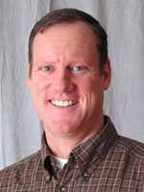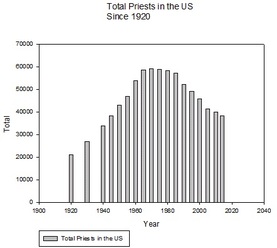| In the study presented below, once again we see that the pivotal point in time is that of Vatican II and the introduction of the new Mass. For those who are intellectually honest with eyes to see and ears to hear, no commentary is needed. From Chapter 7 of the Gospel of Matthew: [16] By their fruits you shall know them. Do men gather grapes of thorns, or figs of thistles? [17] Even so every good tree bringeth forth good fruit, and the evil tree bringeth forth evil fruit. [18] A good tree cannot bring forth evil fruit, neither can an evil tree bring forth good fruit. [19] Every tree that bringeth not forth good fruit, shall be cut down, and shall be cast into the fire. [20] Wherefore by their fruits you shall know them. |
On October 24, 2016, while addressing the 36th General Congregation of the Society of Jesus, [1] Pope Francis lamented a “rigidity” he has discovered among today’s seminarians, in which they are guilty of a “decadent scholasticism” which was widespread in the seminaries prior to Vatican II. This rigidity is focused on rules, of the sort that distinguish between “yes you can” and “no you cannot.” The Jesuit Pope goes on to say that “Not promoting vocations is ecclesial tubal ligation,” and even a form of “suicide.”
There’s so much to unpack in just these few comments that it will require two installments.
First one must consider the context in which these remarks were made: a Jesuit Pope among his fellow Jesuits. In other words, he was free to speak frankly, so we can assume that his words represent what he firmly believes.
Next we must distinguish between the Jesuits prior to the Second Vatican Council and the Jesuits since that time. To go through a litany of great Jesuits, starting with St. Ignatius, through all of their missionary, apologetic and intellectual contributions would be to repeat a well-known story. But it ends in 1965, or perhaps sometime prior to 1965. The Jesuits are no longer recognizable as the great missionary order that they once were. Their activities since that time constitute another well-known story: one that is ongoing, and it certainly will not have a happy ending. The collapse of this formerly great order of evangelists, educators, missionaries, and intellectuals is tragic beyond comprehension.
Although the extinction of the Jesuits has been commented upon previously [2][3], that was in 2011 and at that time we did not have a Jesuit in the Chair of Peter. Also at that time no attempt was made to actually predict the date of extinction of the Jesuits.
| Above, Francis, who is in charge of the "active ministry of Peter," curries favor with Martin Scorsese for his latest film, "Silence", on Jesuits in Japan which teaches and justifies apostasy. In Scorsese's film "The Last Temptation of Christ" is featured a blasphemous dream sequence in which Our Lord and Savior Jesus Christ has sex with Saint Mary Magdalen. Read The Remnant story here. | Prior to Vatican II the Jesuits were increasing at a sustained rate of about 500 novices/year in male religious, from which the future Jesuit priests were selected [4]. Such high number of vocations a year can be explained by their direct engagement to institutes for education of boys and young adults. This is the period condemned by Francis, the period in which “decadent scholasticism” ruled the seminaries and Catholic schools. The Jesuits, like all other religious, seem to have been at least to some extent focused on “rules.” Among those rules would have been those regulating the prayer life of the priests and all male religious. Recalling the maxim of Lex Orandi, Lex Crededi by which we have always held that the way we pray as Catholics determines what we believe, we remind Pope Francis that the Jesuits, during their better days, followed the traditional liturgy and offered Mass in what we now know as the “Extraordinary Form.” The rule of prayer governed their rule of belief prior to the Second Vatican Council, just as it does now. Figure 1 shows the increase of all male Jesuit religious prior to 1965, and Figure 2 shows the decrease of all male religious as well as Jesuit priests since 1965. Behold the difference. |
- that nothing changes to reverse the trend, and
- that the decline follows an exponential decay pattern similar to that found among the religious in the USA [5].
If these two basic assumptions hold true, by approximately year 2120 the once-powerful order will have declined to 1/10th of its 1965 strength and the number of priests will have been reduced to around 3500.
This decline of the Jesuits was separately modeled by an engineer using a different technique, based on an incremental extrapolation method. The results are similar, although a distinction is drawn between the rate of decline witnessed from 1965-1975 and that found from 1975 to the present. Also this model is applied to all Jesuit male religious. Figure 3 shows data points used for this analysis of the decline of male religious, projected into the future by Simulation 1 with an annual decline increment of about -1.4% per year, which is the average for the Jesuits of the past 40 years (from 1975 to 2015) and Simulation 2 with a decline increment of -2% per year, which was the rate found during the first decade after the Second Vatican Council (from 1965 to 1975).
These models, developed independently (some by a Computer Scientist and the others by a Scientific Engineer) all agree that the Jesuits have a half-life of something in the vicinity of 50 years and will cease to exist by sometime within the next couple of centuries.
This means that we can look forward to Jesuits telling us how to encourage vocations for the next couple of hundred years, until at some point they go extinct. How soon will that be? It depends on whether their rate of decline is the current rate or that found during the first ten years after the Great Council.
It could be within this century. A careful examination of both curves in Figure 2 show an essentially linear decline from 1980 to the present, so dropping the exponential decay assumption and using a linear model instead:
A similar result can be seen in Simulation 0 in Figure 3, the linear extrapolation by the average decline during the last 30 years which determines that the last surviving Jesuit expires about 2070.
The difference between an exponential decay model and a linear model can be considered like the difference between going down a slide that “flattens out” at the end and allows you to come to a slow stop, and one that just goes straight to the ground so that you would slam into the dirt at a high velocity, possibly breaking something. Since the data fits a linear model and the Jesuits are showing no signs of changing the direction they've taken over the past 50 years, this model is probably accurate. In other words, the Jesuits are most likely on a fast track to extinction.
Using any of these models, it should be clear that the Jesuits really have no business guiding the Church when it comes to vocations. We have already seen the strong correlation between vocations and traditional Catholic practices and spirituality. The Priest Shortage, Manufactured Crisis? [5] shows the stark contrast when any diocese or group of religious recovers our traditional patrimony: prayer life, Mass, practices and belief. And Francis’ predecessor made it clear that these practices cannot be forbidden. [6]
So here is the contradiction in which Francis is trapped: what is it that he wants for the Church? Is it vocations? Then that comes with the pre-conciliar “rules” along with the old Mass, and “rigid” seminarians. Or is he insisting on the post-conciliar lack of rules, free-for-all liturgy, “gray areas,” and the consequential loss of vocations?
The latest doctrinal drift comes from the Pontifical Academy of Sciences in the form of guidelines stating that priests should be “'promoters' of 'appropriate care for everything connected to the protection of creation'.” In other words, they are to be advocates of global climate change theories [7]. We all should be concerned about the environment in which we live, but the salvation of souls is the supreme law of the Church. Will the idea of sacrificing everything in life to become an environmental activist bring young men into the seminaries in droves? There is no mathematical model for this prediction, but I will make it anyway: if our clergy are to become environmental activists dedicated to shaping a Paradise on earth, they will join the Jesuits on the fast track to extinction.
To return to the comments made by Francis to his fellow Jesuits, he has both acknowledged that we have a vocations crisis, and placed himself in firm opposition to the solution to this crisis. Living with such a contradiction must be maddening. Perhaps it is madness that is causing him to lead the Catholic Church to the suicide of which he speaks. Cultural Suicide, a self-imposed form of Cultural Genocide, will be addressed in the next article.
[1] http://www.catholicculture.org/news/headlines/index.cfm?storyid=30038, Catholic World News, November 25, 2016.
[2] Catholic World News, “Extinction, accepted in 'the Jesuit tradition'”, Phil Lawler, Apr 26, 2011.
[3] http://www.catholicculture.org/commentary/otn.cfm?ID=795
[4] Statistical data from ‘The Hierarchy of the Catholic Church’ (http://www.catholic-hierarchy.org/)
[5] “The Priest Shortage: A Manufactured Crisis?” On Christendom Restoration Society, Inc., January 2015.
[6] Apostolic Letter Summorum Pontificum, issued motu propio by Pope Benedict XVI on July 7, 2007.
[7] http://www.dailymail.co.uk/news/article-4020344/New-Catholic-priests-learn-climate-change-studies-drive-church-cut-global-warming.html
Permission granted to promote with the stipulation that Christendom Restoration Society is credited at the top and bottom of the post along with a links back to the original article on our web site.
| About the Authors: David L. Sonnier is an Associate Professor of Computer Science at Lyon College in Batesville, Arkansas, and a retired Lieutenant Colonel in the United States Army and serves on the Board of Christendom Restoration Society. Other works by David Sonnier include:
|
| Jack P. Oostveen is educated as a Practical and Scientific Civil Engineer, experienced consultant and research engineer in the field of Soil Mechanics and Foundation Engineering. Since 2012 he is Emeritus Assistant Professor in Soil Mechanics and Foundation Engineering of the Delft University of Technology in The Netherlands. Jack converted into the Roman Catholic Church in 1970. Since 1979 he has been involved with the "Interparochie Maria van Nazareth," an unofficial group of faithful attached to the Traditional Mass in Delft, The Netherlands and board-member from 1986 to 1996. |
- Board member from 2001 to 2003 and from 2005 to 2013
- President from 2006 to 2007, during which the Motu Proprio Summorum Pontificum was received
- Vice-president from 2005-2006 and from 2007 to 2013
- Was involved by a world wide action pro Franciscan Friars of the Immaculate in 2014
Author of the first systematic analysis of the sudden and precipitous decline of the clerical population dealt specifically with the Netherlands:
- “Prospectives for Growth: A System Dynamics Study of the Roman Catholic Priest Population of the Netherlands”. Oostveen J.P. and Sweeney D.J.. International Conference of the System Dynamics Society. Seville. Spain. 1986. 1-183;
- Statistical evaluation of the Roman Catholic Church in the Netherlands. Oostveen. J.P. 1997; http://www.ecclesiadei.nl/rkstat/index.html.
And more recently:
- “Vatican II, the intrinsic risks for failures and clarity of the interpretation", http://www.ecclesiadei.nl/docs/clarity.html, Oostveen, J.P., 2015;
- “Risk analysis of Vatican II”. http://www.ecclesiadei.nl/docs/risk_analysis.html. Oostveen. J.P.. 2016;
- "Letters to Rome", http://www.ecclesiadei.nl/docs/letters_to_Rome.html, Oostveen, J.P., 2016







































 RSS Feed
RSS Feed